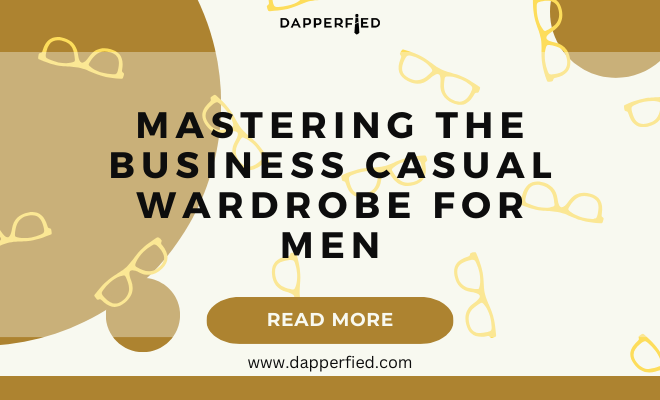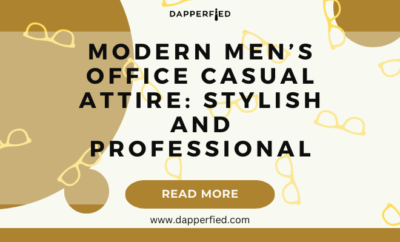
Men's Style
Mastering the Business Casual Wardrobe for Men
Business casual is a dress code that is commonly seen in professional settings. It is a step down from traditional business attire, which typically includes a suit and tie for men and a pantsuit or skirt suit for women. Business casual allows for more flexibility and comfort while still maintaining a professional appearance. When dressing in business casual attire, it’s important to strike the right balance between looking polished and being comfortable. For men, this might mean wearing a collared shirt with dress pants and loafers, while women might opt for a blouse with tailored trousers and flats. Understanding the nuances of the business casual dress code is essential for making the right fashion choices in the workplace.
Business casual attire can vary depending on the industry and company culture. In more conservative industries, such as finance or law, business casual might still require a blazer or sports coat for men and a tailored dress or skirt for women. In creative or tech industries, the dress code might be more relaxed, allowing for jeans and sneakers. It’s important to take cues from colleagues and company guidelines to ensure that your outfit is appropriate for the workplace. Ultimately, the goal of business casual attire is to look professional while still feeling comfortable and confident in what you’re wearing.
Key Takeaways
- Business casual dress code is a blend of professional and relaxed attire
- A versatile wardrobe includes mix-and-match pieces for different looks
- Choosing the right fit is crucial for a polished appearance
- Incorporating color and patterns can add personality to your outfit
- Selecting the right footwear is important for completing the business casual look
Building a Versatile Wardrobe
When it comes to building a versatile wardrobe for business casual attire, it’s important to invest in key pieces that can be mixed and matched to create different looks. For men, this might include a few pairs of tailored trousers in neutral colors like navy, grey, and black, along with a selection of collared shirts in classic patterns like stripes or checks. Adding a couple of blazers in different colors can also help elevate the look when needed. For women, versatile pieces might include tailored trousers, pencil skirts, blouses, and dresses in neutral colors like black, navy, and grey. Having a few blazers or cardigans on hand can also help add polish to an outfit.
In addition to clothing, it’s important to invest in quality accessories that can help elevate your business casual wardrobe. For men, this might include a selection of ties, pocket squares, and leather belts and shoes. For women, accessories like statement necklaces, scarves, and classic pumps can help add interest to an outfit. By building a wardrobe with versatile pieces that can be mixed and matched, you can create a variety of looks without having to constantly buy new clothing.
Choosing the Right Fit
One of the most important aspects of dressing in business casual attire is ensuring that your clothing fits well. Ill-fitting clothing can make even the most stylish outfit look sloppy and unprofessional. For men, this means making sure that dress shirts and trousers are the right length and width, and that blazers or sports coats fit well in the shoulders and torso. For women, it’s important to pay attention to the fit of dresses, skirts, and blouses, making sure that they are not too tight or too loose. Tailoring can be a great investment to ensure that your clothing fits perfectly.
When it comes to fit, it’s also important to consider the overall silhouette of your outfit. For men, this might mean opting for slim-fit trousers and shirts for a modern look, while women might choose tailored pieces that flatter their figure without being too revealing. Ultimately, choosing the right fit for your body type can help you feel more confident and comfortable in your business casual attire.
Incorporating Color and Patterns
| Category | Metrics |
|---|---|
| Color | Usage of primary, secondary, and complementary colors |
| Patterns | Frequency of pattern incorporation |
| Visual Appeal | Subjective rating of color and pattern combination |
| Engagement | Effect of color and patterns on user interaction |
While business casual attire often leans towards neutral colors like black, navy, and grey, incorporating color and patterns can help add interest to your outfit. For men, this might mean adding a pop of color with a vibrant tie or pocket square, or opting for dress shirts in classic patterns like stripes or checks. For women, adding color can be as simple as choosing a blouse or dress in a bold hue, or incorporating patterns like polka dots or floral prints.
When incorporating color and patterns into your business casual attire, it’s important to do so in a way that still looks professional. This might mean opting for subtle patterns or muted colors that complement the rest of your outfit. It’s also important to consider the overall color palette of your wardrobe to ensure that everything can be mixed and matched seamlessly.
Selecting the Right Footwear
Choosing the right footwear is an important aspect of dressing in business casual attire. For men, this might mean opting for leather loafers or oxfords in classic colors like black or brown. Avoiding sneakers or overly casual shoes is key to maintaining a polished appearance. For women, classic pumps or flats in neutral colors are a safe bet for business casual attire. Avoiding overly high heels or sandals is important to ensure that your footwear looks professional.
In addition to choosing the right style of footwear, it’s also important to consider comfort. Since business casual attire often requires being on your feet for long periods of time, opting for shoes with cushioning and support can help keep you comfortable throughout the day. Investing in quality footwear that is both stylish and comfortable is essential for completing your business casual look.
Adding Accessories

Accessories can play a key role in elevating your business casual attire. For men, this might include adding a watch, tie clip, or pocket square to their outfit for a polished touch. For women, accessories like statement necklaces, scarves, or a structured handbag can help add interest to an outfit without being too distracting. When adding accessories to your business casual attire, it’s important to strike the right balance between looking put-together and not overdoing it.
In addition to traditional accessories like jewelry and handbags, it’s also important to consider practical items like belts or umbrellas that can complement your outfit while serving a functional purpose. By adding accessories thoughtfully, you can elevate your business casual attire without looking too flashy or out of place.
Maintaining a Polished Appearance
Maintaining a polished appearance in business casual attire goes beyond just choosing the right clothing and accessories. It also involves paying attention to grooming and personal hygiene. For men, this might mean keeping facial hair neatly groomed and ensuring that hair is well-kept. For women, maintaining a polished appearance might involve keeping nails manicured and hair styled neatly.
In addition to grooming, it’s important to pay attention to the condition of your clothing. Keeping clothing clean and well-maintained is essential for looking professional in business casual attire. This might involve regular dry cleaning or laundering of clothing items, as well as ensuring that shoes are polished and in good condition.

Ultimately, maintaining a polished appearance in business casual attire involves paying attention to all aspects of your appearance, from clothing and accessories to grooming and personal hygiene. By taking care with each detail, you can ensure that you always look professional and put-together in the workplace.
Looking to elevate your business casual wardrobe for men? Check out our article on tips for looking your best in tailored suits. Whether you’re aiming for a polished office look or a sophisticated event ensemble, this guide has you covered. From selecting the perfect designer shirts to mastering the art of tailored suits, Dapperfied has all the style advice you need.
FAQs
What is a business casual dress code for men?
Business casual for men typically includes a collared shirt, dress slacks or chinos, and dress shoes. Ties are usually optional, and jackets may or may not be required depending on the workplace.
What are some examples of business casual attire for men?
Examples of business casual attire for men include a button-down shirt with dress pants or chinos, a polo shirt with khakis, or a sweater with tailored trousers. Dress shoes or loafers are typically worn with business casual outfits.
Can men wear jeans in a business casual setting?
In some workplaces, dark, well-fitted jeans may be acceptable as part of a business casual wardrobe for men. However, it’s important to check the specific dress code of the company or office before wearing jeans to work.
Are there any specific colors or patterns to avoid in business casual attire for men?
When it comes to business casual attire for men, it’s generally best to avoid overly bright or flashy colors, as well as loud patterns. Neutral colors such as navy, gray, and black are often preferred, and subtle patterns like pinstripes or small checks are acceptable.
What accessories are appropriate for a business casual wardrobe for men?
Accessories that are appropriate for a business casual wardrobe for men include a leather belt, a classic watch, and possibly a tie or pocket square for a more polished look. It’s important to keep accessories understated and professional in a business casual setting.














